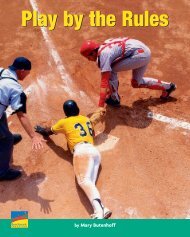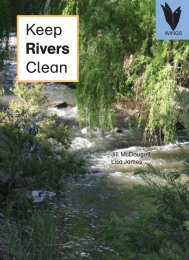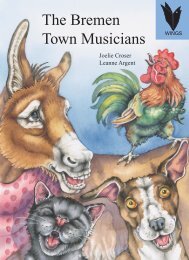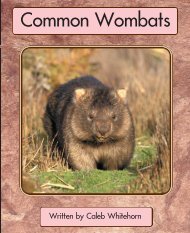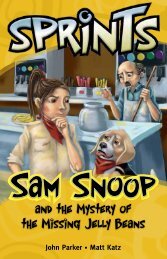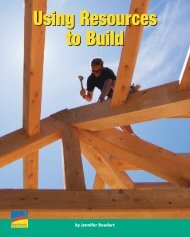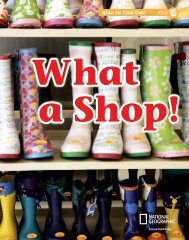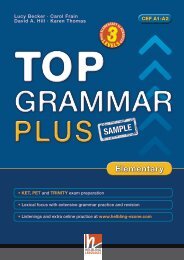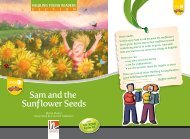inspection
Preview - Stanford House HK
Preview - Stanford House HK
- No tags were found...
Create successful ePaper yourself
Turn your PDF publications into a flip-book with our unique Google optimized e-Paper software.
For teachers'<strong>inspection</strong> ONLYAuthorsTimothy Rasinski and Roger Heym
For teachers'<strong>inspection</strong> ONLYTable of ContentsIntroduction and Research Base. . . . . . . . . . . . . . . . . . . . . . . . . . . . . . . . . . . .5The Word Steps Lesson Plan. . . . . . . . . . . . . . . . . . . . . . . . . . . . . . . . . . . . . . .8Standards Correlations . . . . . . . . . . . . . . . . . . . . . . . . . . . . . . . . . . . . . . . . . .12Quick Start . . . . . . . . . . . . . . . . . . . . . . . . . . . . . . . . . . . . . . . . . . . . . . . . . . . .13Lesson 1: Shapes . . . . . . . . . . . . . . . . . . . . . . . . . . . . . . . . . . . . . . . . . . . . .14Lesson 2: U.S. History. . . . . . . . . . . . . . . . . . . . . . . . . . . . . . . . . . . . . . . . .16Lesson 3 U.S. History . . . . . . . . . . . . . . . . . . . . . . . . . . . . . . . . . . . . . . . . .18Lesson 4: Books. . . . . . . . . . . . . . . . . . . . . . . . . . . . . . . . . . . . . . . . . . . . . .20Lesson 5: School Life . . . . . . . . . . . . . . . . . . . . . . . . . . . . . . . . . . . . . . . . .22Lesson 6: Parts of Things. . . . . . . . . . . . . . . . . . . . . . . . . . . . . . . . . . . . . . .24Lesson 7: Vocabulary . . . . . . . . . . . . . . . . . . . . . . . . . . . . . . . . . . . . . . . . . .26Lesson 8: Vocabulary . . . . . . . . . . . . . . . . . . . . . . . . . . . . . . . . . . . . . . . . . .28Lesson 9: Vocabulary . . . . . . . . . . . . . . . . . . . . . . . . . . . . . . . . . . . . . . . . . .30Lesson 10: Vocabulary . . . . . . . . . . . . . . . . . . . . . . . . . . . . . . . . . . . . . . . . .32Lesson 11: Vocabulary . . . . . . . . . . . . . . . . . . . . . . . . . . . . . . . . . . . . . . . . .34Lesson 12: Vocabulary . . . . . . . . . . . . . . . . . . . . . . . . . . . . . . . . . . . . . . . . .36Lesson 13: Vocabulary . . . . . . . . . . . . . . . . . . . . . . . . . . . . . . . . . . . . . . . . .38Lesson 14: Math. . . . . . . . . . . . . . . . . . . . . . . . . . . . . . . . . . . . . . . . . . . . . .40Lesson 15: Social Studies . . . . . . . . . . . . . . . . . . . . . . . . . . . . . . . . . . . . . .42Lesson 16: Social Studies . . . . . . . . . . . . . . . . . . . . . . . . . . . . . . . . . . . . . .44Lesson 17: Social Studies . . . . . . . . . . . . . . . . . . . . . . . . . . . . . . . . . . . . . .46Lesson 18: Social Studies . . . . . . . . . . . . . . . . . . . . . . . . . . . . . . . . . . . . . .48Lesson 19: Social Studies . . . . . . . . . . . . . . . . . . . . . . . . . . . . . . . . . . . . . .50Lesson 20: Social Studies . . . . . . . . . . . . . . . . . . . . . . . . . . . . . . . . . . . . . .52Lesson 21: Science. . . . . . . . . . . . . . . . . . . . . . . . . . . . . . . . . . . . . . . . . . . .54Lesson 22: How We Live . . . . . . . . . . . . . . . . . . . . . . . . . . . . . . . . . . . . . . .56Lesson 23: Social Studies . . . . . . . . . . . . . . . . . . . . . . . . . . . . . . . . . . . . . .58Lesson 24: States . . . . . . . . . . . . . . . . . . . . . . . . . . . . . . . . . . . . . . . . . . . . .60Lesson 25: Adjectives . . . . . . . . . . . . . . . . . . . . . . . . . . . . . . . . . . . . . . . . .62Lesson 26: American History. . . . . . . . . . . . . . . . . . . . . . . . . . . . . . . . . . . .64Lesson 27: Vocabulary . . . . . . . . . . . . . . . . . . . . . . . . . . . . . . . . . . . . . . . . .66Lesson 28: Vocabulary . . . . . . . . . . . . . . . . . . . . . . . . . . . . . . . . . . . . . . . . .68Lesson 29: Geography . . . . . . . . . . . . . . . . . . . . . . . . . . . . . . . . . . . . . . . . .70Lesson 30: Vocabulary . . . . . . . . . . . . . . . . . . . . . . . . . . . . . . . . . . . . . . . . .72© Shell Education 3 #50629 Word Steps
For teachers'<strong>inspection</strong> ONLYLesson 31: Vocabulary . . . . . . . . . . . . . . . . . . . . . . . . . . . . . . . . . . . . . . . . .74Lesson 32: U.S. Presidents. . . . . . . . . . . . . . . . . . . . . . . . . . . . . . . . . . . . . .76Lesson 33: Vocabulary . . . . . . . . . . . . . . . . . . . . . . . . . . . . . . . . . . . . . . . . .78Lesson 34: U.S. History. . . . . . . . . . . . . . . . . . . . . . . . . . . . . . . . . . . . . . . .80Lesson 35: U.S. History. . . . . . . . . . . . . . . . . . . . . . . . . . . . . . . . . . . . . . . .82Lesson 36: Vocabulary . . . . . . . . . . . . . . . . . . . . . . . . . . . . . . . . . . . . . . . . .84Lesson 37: How Things Happen . . . . . . . . . . . . . . . . . . . . . . . . . . . . . . . . .86Lesson 38: State Government . . . . . . . . . . . . . . . . . . . . . . . . . . . . . . . . . . .88Lesson 39: Science. . . . . . . . . . . . . . . . . . . . . . . . . . . . . . . . . . . . . . . . . . . .90Lesson 40: Vocabulary . . . . . . . . . . . . . . . . . . . . . . . . . . . . . . . . . . . . . . . . .92Lesson 41: Writing. . . . . . . . . . . . . . . . . . . . . . . . . . . . . . . . . . . . . . . . . . . .94Lesson 42: Vocabulary . . . . . . . . . . . . . . . . . . . . . . . . . . . . . . . . . . . . . . . . .96Lesson 43: Science. . . . . . . . . . . . . . . . . . . . . . . . . . . . . . . . . . . . . . . . . . . .98Lesson 44: Science. . . . . . . . . . . . . . . . . . . . . . . . . . . . . . . . . . . . . . . . . . .100Lesson 45: Science. . . . . . . . . . . . . . . . . . . . . . . . . . . . . . . . . . . . . . . . . . .102Lesson 46: Science. . . . . . . . . . . . . . . . . . . . . . . . . . . . . . . . . . . . . . . . . . .104Lesson 47: Science. . . . . . . . . . . . . . . . . . . . . . . . . . . . . . . . . . . . . . . . . . .106Lesson 48: Social Studies . . . . . . . . . . . . . . . . . . . . . . . . . . . . . . . . . . . . .108Lesson 49: Social Studies . . . . . . . . . . . . . . . . . . . . . . . . . . . . . . . . . . . . .110Lesson 50: Social Studies . . . . . . . . . . . . . . . . . . . . . . . . . . . . . . . . . . . . .112Lesson 51: Mathematics . . . . . . . . . . . . . . . . . . . . . . . . . . . . . . . . . . . . . .114Lesson 52: Science. . . . . . . . . . . . . . . . . . . . . . . . . . . . . . . . . . . . . . . . . . .116Lesson 53: Social Studies . . . . . . . . . . . . . . . . . . . . . . . . . . . . . . . . . . . . .118Lesson 54: Science. . . . . . . . . . . . . . . . . . . . . . . . . . . . . . . . . . . . . . . . . . .120Lesson 55: Vocabulary . . . . . . . . . . . . . . . . . . . . . . . . . . . . . . . . . . . . . . . .122Lesson 56: Vocabulary . . . . . . . . . . . . . . . . . . . . . . . . . . . . . . . . . . . . . . . .124Lesson 57: Vocabulary . . . . . . . . . . . . . . . . . . . . . . . . . . . . . . . . . . . . . . . .126Lesson 58: Vocabulary . . . . . . . . . . . . . . . . . . . . . . . . . . . . . . . . . . . . . . . .128Lesson 59: Vocabulary . . . . . . . . . . . . . . . . . . . . . . . . . . . . . . . . . . . . . . . .130Lesson 60: Vocabulary . . . . . . . . . . . . . . . . . . . . . . . . . . . . . . . . . . . . . . . .132About the Authors . . . . . . . . . . . . . . . . . . . . . . . . . . . . . . . . . . . . . . . . . . . . .135References. . . . . . . . . . . . . . . . . . . . . . . . . . . . . . . . . . . . . . . . . . . . . . . . . . . .136#50629 Word Steps 4 © Shell Education
For teachers'<strong>inspection</strong> ONLYQuick StartIf students need guidance to work the Word Steps puzzles, use the followingprocedures:1. Choose the lesson you will teach. Duplicate the blank student worksheet bycopying the first page of the lesson or using the printable copy from the CD.2. Give each student a copy of the worksheet. Make a transparency or projecta copy of the blank worksheet onto a whiteboard to be filled in as studentsare guided through the clues.3. Read clue 1 with the students and help them determine the word for rowone of the Word Steps puzzle. The second page of each Word Steps puzzleis a filled-in worksheet to be used as an Answer Key.4. Fill in row 1 of the Word Steps puzzle.5. Look at the shaded boxes with boldfaced text in them. Transfer these lettersinto the boxes directly below them. These letters will serve as additionalclues to the next word.6. Proceed to read the clues and fill in the boxes, transferring the grayed letterseach time.7. When all the boxes are filled in, work together to choose words that willappropriately fill the blanks in the paragraph found on each worksheet. Notall of the words will be used.The 60 Word Steps lessons follow. Remember, the first page of each lesson is thestudent page. The second page is the Answer Key and can be used to guide thelesson.1. s q u a r e2. . . . a r e n a3. . . . . r e a l i z e d4. . . . . . . . . . r e d e f i n e5. . . . . . . . . . . . . . . i n e v i t a b l e© Shell Education 13 #50629 Word Steps
#50629 Word Steps 14 © Shell EducationName____________________________________1.2. . . .3. . . . .4. . . . . . . . . .5. . . . . . . . . . . . . . .6. . . . . . . . . . . . . . . . . . . .7. . . . . . . . . . . . . . . . . . . . . . .8. . . . . . . . . . . . . . . . . . . . .9. . . . . . . . . . . . . . . . . .10. . . . . . . . . . . . . . . .11. . . . . . . . . .12. . . . . . .Clues1. a 4-sided shape with equal sides and 4 right angles2. a large building to see concerts and sports, shaped as an oval orrectangle3. to have finally fully understood4. to give a definition of a word again5. something that will certainly happen; unavoidable6. a small square or rectangular pad of paper or a round medicinepill7. stationery with a name and address that is often rectangular inshape8. opposite of son, female related to her parents9. put this in your ear to block out noise or to hear music10. something one thinks or imagines; a plan11. excellent, wonderful, very good12. crunchy, easily broken, or invigorating, fresh airLesson 1ShapesMan With a PlanThe new ___________________________ was built in the shape of a___________________. The designer came up with a very interesting_______________ that he first wrote on his ___________________. Itwas later sent out for others to see on his official _________________.His young _____________________ _____________________ that itwas a ______________________ design. It became _______________that it would be built as soon as possible.For teachers'<strong>inspection</strong> ONLY
© Shell Education 15 #50629 Word StepsClues1. a 4-sided shape with equal sides and 4 right angles2. a large building to see concerts and sports, shaped as an oval orrectangle3. to have finally fully understood4. to give a definition of a word again5. something that will certainly happen; unavoidable6. a small square or rectangular pad of paper or a round medicinepill7. stationery with a name and address that is often rectangular inshape8. opposite of son, female related to her parents9. put this in your ear to block out noise or to hear music10. something one thinks or imagines; a plan11. excellent, wonderful, very good12. crunchy, easily broken or invigorating, fresh airLesson 1 Answer Key1. s q u a r e2. . . . a r e n aShapes3. . . . . r e a l i z e d4. . . . . . . . . . r e d e f i n e5. . . . . . . . . . . . . . . i n e v i t a b l e6. . . . . . . . . . . . . . . . . . . t a b l e t7. . . . . . . . . . . . . . . . . . . . . . . l e t t e r h e a d8. . . . . . . . . . . . . . . . . . . . . d a u g h t e r9. . . . . . . . . . . . . . . . . . e a r p l u g10. . . . . . . . . . . . . . . . i d e a11. . . . . . . . . . s p l e n d i d12. . . . . . . c r i s pMan With a PlanThe new ___________arena___________ was built in the shape of a_______square_______. The designer came up with a very interesting______idea______ that he first wrote on his _______tablet_______. Itwas later sent out for others to see on his official ____letterhead_____.His young _______daughter_______ _______realized_______ that itwas a ______splendid_______ design. It became _____inevitable____that it would be built as soon as possible.For teachers'<strong>inspection</strong> ONLY
For teachers'<strong>inspection</strong> ONLYThe Word Steps Lesson PlanOverviewThis book provides you with all you need to implement Word Steps lessonswith upper-elementary and middle-grade readers. The lessons are organizedaround academic vocabulary concepts that are normal parts of upper-elementaryand middle school content-area curricula. Each lesson is accompanied by acorresponding worksheet that students use in making a set of words. You simplyneed to make a copy of the appropriate worksheet for each student. Copies areprovided on the enclosed CD for printing convenience. Additionally, you willneed to make a transparency for yourself or project a copy onto an interactivewhiteboard so that you can guide students in making the words that are part ofeach lesson.Each brief lesson or activity begins with a key starter word that students areexpected to know and master from a content area. From that first word, youguide students to use a highlighted portion of the first word to make a secondword that is presented on the next step of the worksheet. A highlighted portion ofthe second word is then used to make a third word on the third step. Each newword is made from a highlighted element of the previous word until a final wordis made. As students move from one word to the next, they are also presentedwith clues that focus their attention to the meaning of each word.For example, in Lesson One, students begin with the word square. In the stepbelow this first word, students use the are in square to make a word that means“a stadium used to present concerts and sporting events”—arena. In the nextstep, students will use the re in arena to make a word that means “to have becomeaware of something or to have understood something”—realized. The ten-minutelesson continues with a portion of one word used to make the next word on thestep below.#50629 Word Steps 8 © Shell Education
For teachers'<strong>inspection</strong> ONLYThe Word Steps Lesson Plan (cont.)The lesson format is easy to follow; however, some of the words may bechallenging for students. We purposefully included challenging words in eachlesson because we wanted to build their vocabularies with words that they willoften find in their academic studies—words that they will find useful in their ownreading and content-area studies in the months and years to come.In addition to providing a few letters for each new word from the previousword, we also provide letter boxes for each word to give students a clue as to thenumber of letters for each word. And for each word, we provide a definition ormeaning clue to keep students’ attention focused on the fact that each word theymake has a specific meaning or meanings.Adaptations for Struggling StudentsAlthough we provide meaningful clues, we know that those clues may not besufficient for many students. You should feel free to add your own clues ordefinitions to the mix or to simply give students the word and provide a sentencewhich helps to illustrate the meaning of each word. You can add additionalsupport for each Word Steps lesson by strategically filling in some of the blankletter boxes in each worksheet before duplicating it for each student. Theidea behind each Word Steps lesson is to provide teachers and students with agamelike vehicle to help students gain access to word meanings and take noteof how words are spelled. Feel free to give students as much support asneeded in order for students to be successful.Using Words in ContextTo complete each lesson, we have also provided a short cloze passage (or set ofsentences) in which students must choose words from the just-completed WordSteps lesson to fill in the blanks in the passage. In this way, students immediatelyapply some of the words they have just made into actual contextual reading andwriting.Once each lesson is complete, you and the students can add selected wordsto a classroom word wall to encourage students to use the words in their oraland written language. Students can also be asked to record the words in theirpersonal word journals for continued study and reference.© Shell Education 9 #50629 Word Steps
For teachers'<strong>inspection</strong> ONLYThe Word Steps Lesson Plan (cont.)Sorting WordsOne of the best follow-up activities for each Word Steps lesson is to have studentssort or categorize the words in various ways. On a blank sheet of paper, studentscan be asked to draw one or more vertical lines to make two or more columns.Next, they label each column with a category specified by the teacher or anotherstudent. Then, students sort the words from the lesson into the appropriatecategories by writing them in the appropriate columns. Categories might includethe following:NounsVerbsWords with PrefixesCompound WordsScience WordsWord Sort IdeasNot NounsNot VerbsWords without PrefixesNot Compound WordsNot Science Words1–2 Syllable Words 3+ Syllable WordsWords with Silent LettersWords with Consonant BlendsPeople WordsPlace WordsWords without Silent LettersWords without Consonant BlendsNot People WordsNot Place WordsAs students become adept at sorting words, you may wish to have them namethe categories. Students will display a surprising degree of creativity in learningvarious ways in which words can be categorized.With each new sort, students not only gain added exposure to words, which iscritical to their sight-word development, but they also analyze the words froma variety of perspectives. This gives them greater control over and knowledgeabout how the words are constructed (spelled) and what they mean.#50629 Word Steps 10 © Shell Education
For teachers'<strong>inspection</strong> ONLYThe Word Steps Lesson Plan (cont.)AssessmentYou may wonder if the words from the Word Steps lessons can be used forassessment. The words in the lessons are certainly worth learning. It is alsoworth determining the degree to which students are mastering these words. Eachweek, students could be asked to spell and write brief explanatory definitions fora subset of words from the week’s lessons selected by the teacher. Or, studentsmight be asked to write an essay or a set of sentences using selected words fromthe week’s lessons. High levels of student performance on the selected wordsshould give teachers sufficient evidence that students are gaining control over allthe words.Be ConsistentAs you can see, the lesson format is quick, simple, fun, and consistent. Thegeneral format for each lesson does not change, although the key concept andwords for each lesson do. By being consistent from one lesson to the next, you arenot spending your time explaining any new or unfamiliar procedures. Studentsknow what to do and spend their time focusing on the letter-sound relationshipsfor each word—the essence of phonics instruction. We are certain that, whetheryou work in a regular classroom setting or in an intervention reading programsuch as Title I or special education, regular use of Word Steps will help studentsdevelop a deeper mastery and appreciation of important words in their learningenvironment, and they will also discover that learning words can be enjoyable,engaging, and worthwhile.Make It Feel Like a GameWord learning is indeed worthwhile, and it can be taught in ways that areengaging and enjoyable. Teachers and students have told us that Word Laddersand Making and Writing Words feel like games played in the classroom. We takethat as a compliment and hope that Word Steps will also become another fun andfavorite word-building activity in your classroom. Think of all the games we playas adults that are word games—Scrabble TM , Boggle TM , Password TM , Buzzword TM ,Taboo TM , Balderdash TM , Bananagrams TM , Quiddler TM , and many more. Thoseof us who like to play word games are very likely to be good readers and goodspellers with strong vocabularies. We feel that the more that word study can feellike a game for students, the more likely it is that they will engage themselves inthe important educational task of word learning.© Shell Education 11 #50629 Word Steps



